University of Sunderland APC308 Financial Management Assignment 2019
VerifiedAdded on 2023/01/11
|14
|3220
|68
Homework Assignment
AI Summary
This financial management assignment addresses two key areas: long-term finance, specifically equity finance, and investment appraisal techniques. The assignment begins with a calculation of profit after tax on shareholders' funds, followed by an evaluation of various terms related to equity finance, including the calculation of the number of shares to be issued, theoretical ex-rights price, and expected earnings per share under different issue price scenarios. The assignment then assesses the benefits of scrip dividends for both shareholders and companies. The second part of the assignment focuses on investment appraisal techniques, including payback period, accounting rate of return (ARR), net present value (NPV), and internal rate of return (IRR), with calculations and interpretations for a hypothetical scenario. Finally, the assignment critically evaluates the benefits and drawbacks of each investment appraisal technique.

Financial Management
Paraphrase This Document
Need a fresh take? Get an instant paraphrase of this document with our AI Paraphraser
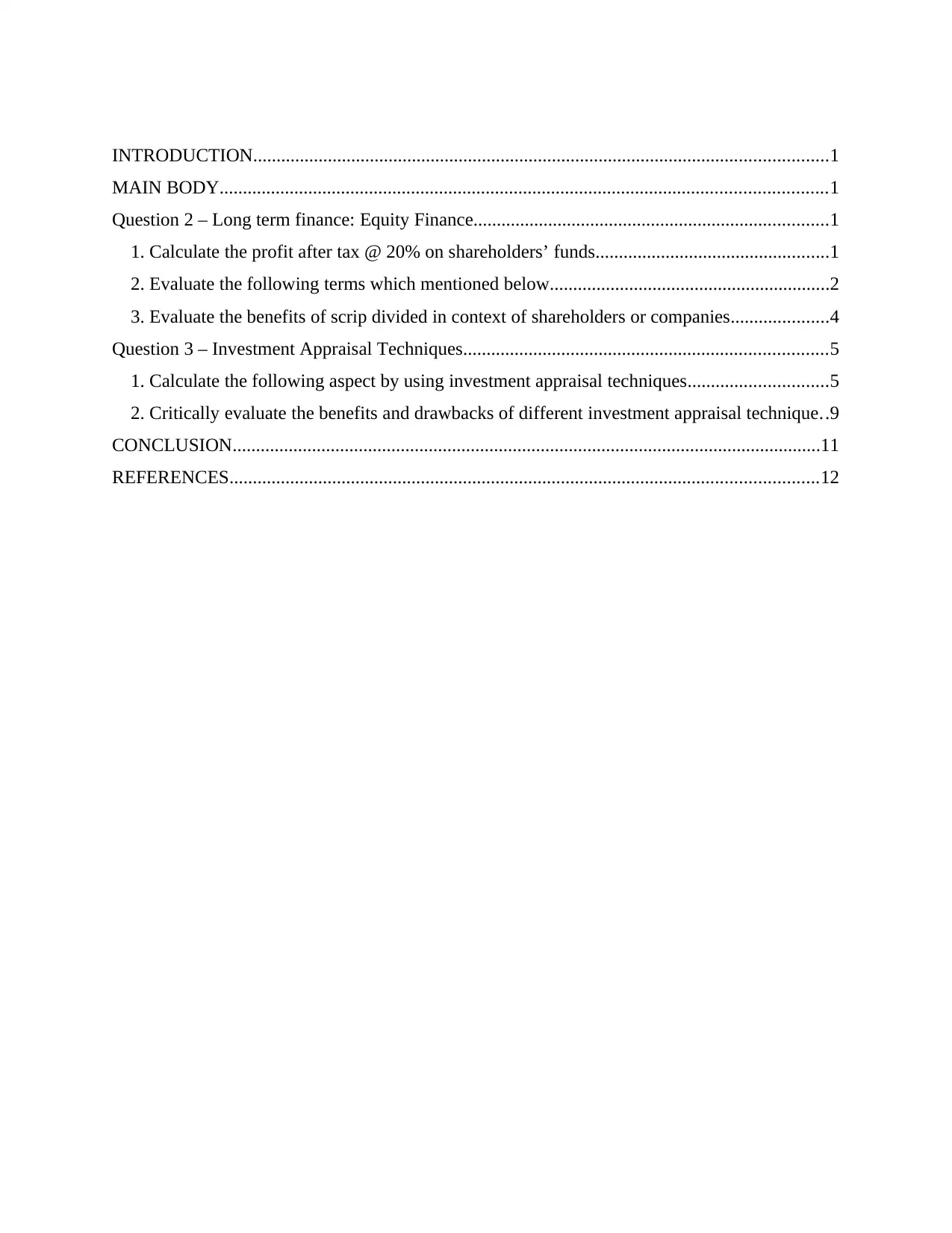
INTRODUCTION...........................................................................................................................1
MAIN BODY..................................................................................................................................1
Question 2 – Long term finance: Equity Finance............................................................................1
1. Calculate the profit after tax @ 20% on shareholders’ funds..................................................1
2. Evaluate the following terms which mentioned below............................................................2
3. Evaluate the benefits of scrip divided in context of shareholders or companies.....................4
Question 3 – Investment Appraisal Techniques..............................................................................5
1. Calculate the following aspect by using investment appraisal techniques..............................5
2. Critically evaluate the benefits and drawbacks of different investment appraisal technique..9
CONCLUSION..............................................................................................................................11
REFERENCES..............................................................................................................................12
MAIN BODY..................................................................................................................................1
Question 2 – Long term finance: Equity Finance............................................................................1
1. Calculate the profit after tax @ 20% on shareholders’ funds..................................................1
2. Evaluate the following terms which mentioned below............................................................2
3. Evaluate the benefits of scrip divided in context of shareholders or companies.....................4
Question 3 – Investment Appraisal Techniques..............................................................................5
1. Calculate the following aspect by using investment appraisal techniques..............................5
2. Critically evaluate the benefits and drawbacks of different investment appraisal technique..9
CONCLUSION..............................................................................................................................11
REFERENCES..............................................................................................................................12
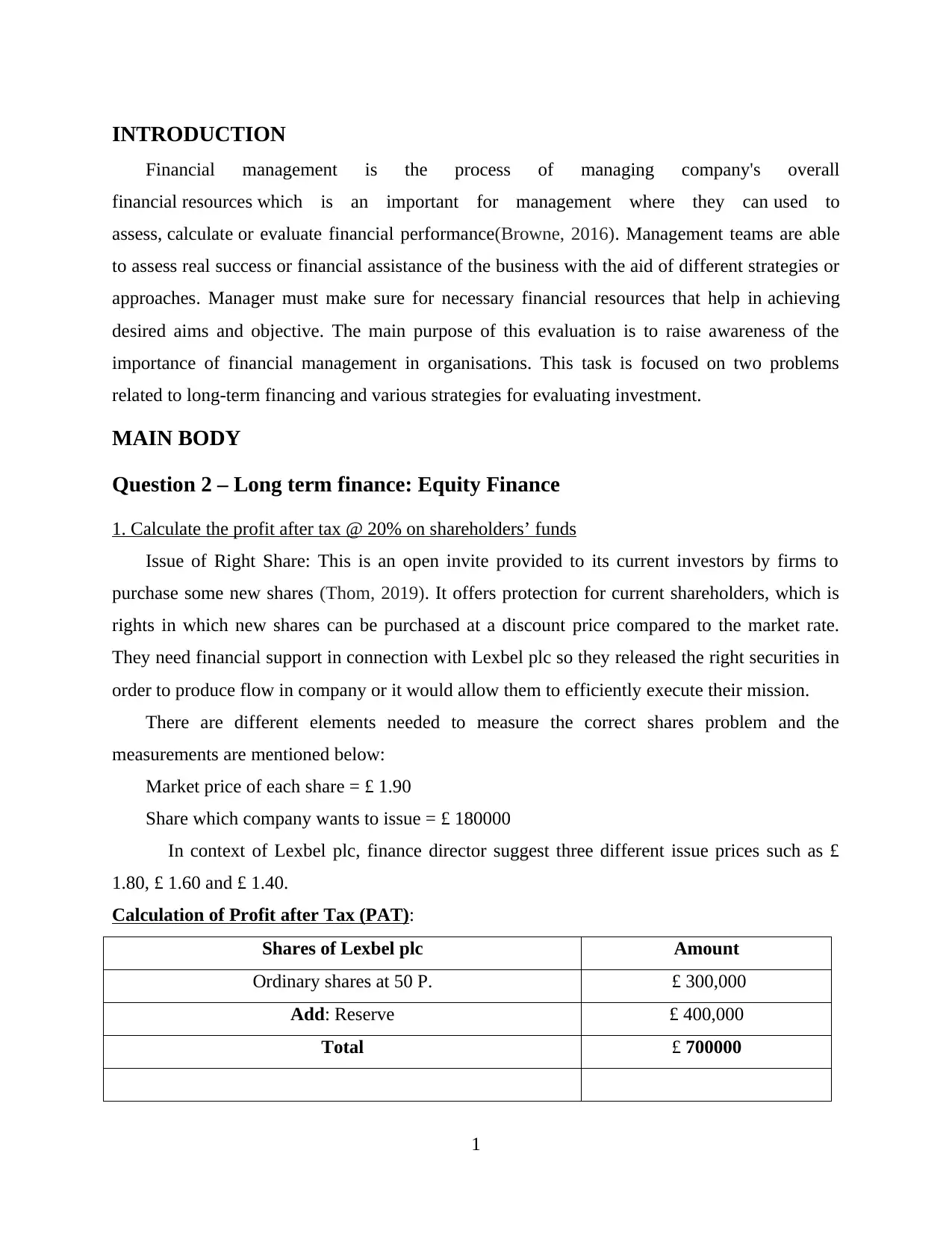
INTRODUCTION
Financial management is the process of managing company's overall
financial resources which is an important for management where they can used to
assess, calculate or evaluate financial performance(Browne, 2016). Management teams are able
to assess real success or financial assistance of the business with the aid of different strategies or
approaches. Manager must make sure for necessary financial resources that help in achieving
desired aims and objective. The main purpose of this evaluation is to raise awareness of the
importance of financial management in organisations. This task is focused on two problems
related to long-term financing and various strategies for evaluating investment.
MAIN BODY
Question 2 – Long term finance: Equity Finance
1. Calculate the profit after tax @ 20% on shareholders’ funds
Issue of Right Share: This is an open invite provided to its current investors by firms to
purchase some new shares (Thom, 2019). It offers protection for current shareholders, which is
rights in which new shares can be purchased at a discount price compared to the market rate.
They need financial support in connection with Lexbel plc so they released the right securities in
order to produce flow in company or it would allow them to efficiently execute their mission.
There are different elements needed to measure the correct shares problem and the
measurements are mentioned below:
Market price of each share = £ 1.90
Share which company wants to issue = £ 180000
In context of Lexbel plc, finance director suggest three different issue prices such as £
1.80, £ 1.60 and £ 1.40.
Calculation of Profit after Tax (PAT):
Shares of Lexbel plc Amount
Ordinary shares at 50 P. £ 300,000
Add: Reserve £ 400,000
Total £ 700000
1
Financial management is the process of managing company's overall
financial resources which is an important for management where they can used to
assess, calculate or evaluate financial performance(Browne, 2016). Management teams are able
to assess real success or financial assistance of the business with the aid of different strategies or
approaches. Manager must make sure for necessary financial resources that help in achieving
desired aims and objective. The main purpose of this evaluation is to raise awareness of the
importance of financial management in organisations. This task is focused on two problems
related to long-term financing and various strategies for evaluating investment.
MAIN BODY
Question 2 – Long term finance: Equity Finance
1. Calculate the profit after tax @ 20% on shareholders’ funds
Issue of Right Share: This is an open invite provided to its current investors by firms to
purchase some new shares (Thom, 2019). It offers protection for current shareholders, which is
rights in which new shares can be purchased at a discount price compared to the market rate.
They need financial support in connection with Lexbel plc so they released the right securities in
order to produce flow in company or it would allow them to efficiently execute their mission.
There are different elements needed to measure the correct shares problem and the
measurements are mentioned below:
Market price of each share = £ 1.90
Share which company wants to issue = £ 180000
In context of Lexbel plc, finance director suggest three different issue prices such as £
1.80, £ 1.60 and £ 1.40.
Calculation of Profit after Tax (PAT):
Shares of Lexbel plc Amount
Ordinary shares at 50 P. £ 300,000
Add: Reserve £ 400,000
Total £ 700000
1
⊘ This is a preview!⊘
Do you want full access?
Subscribe today to unlock all pages.

Trusted by 1+ million students worldwide
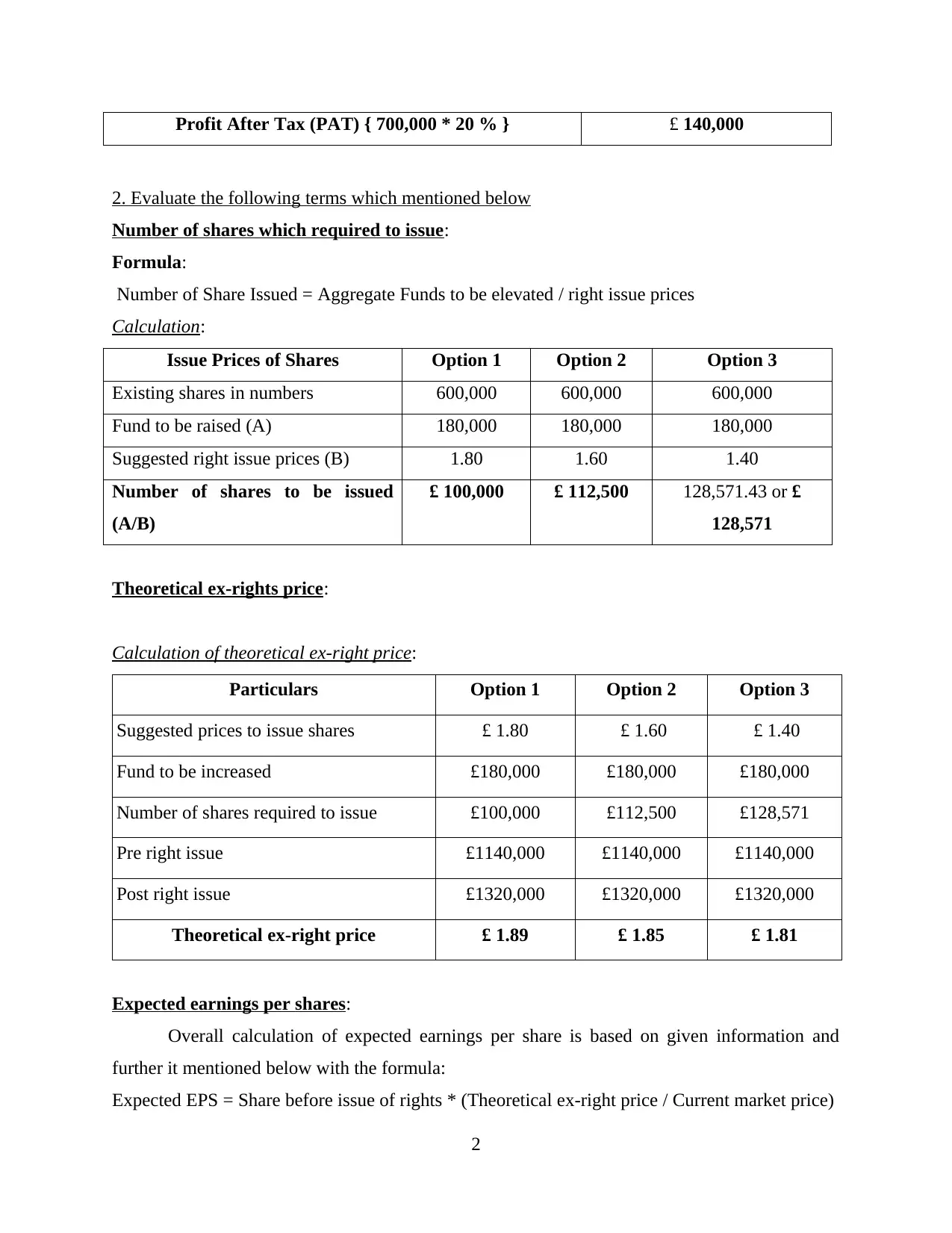
Profit After Tax (PAT) { 700,000 * 20 % } £ 140,000
2. Evaluate the following terms which mentioned below
Number of shares which required to issue:
Formula:
Number of Share Issued = Aggregate Funds to be elevated / right issue prices
Calculation:
Issue Prices of Shares Option 1 Option 2 Option 3
Existing shares in numbers 600,000 600,000 600,000
Fund to be raised (A) 180,000 180,000 180,000
Suggested right issue prices (B) 1.80 1.60 1.40
Number of shares to be issued
(A/B)
£ 100,000 £ 112,500 128,571.43 or £
128,571
Theoretical ex-rights price:
Calculation of theoretical ex-right price:
Particulars Option 1 Option 2 Option 3
Suggested prices to issue shares £ 1.80 £ 1.60 £ 1.40
Fund to be increased £180,000 £180,000 £180,000
Number of shares required to issue £100,000 £112,500 £128,571
Pre right issue £1140,000 £1140,000 £1140,000
Post right issue £1320,000 £1320,000 £1320,000
Theoretical ex-right price £ 1.89 £ 1.85 £ 1.81
Expected earnings per shares:
Overall calculation of expected earnings per share is based on given information and
further it mentioned below with the formula:
Expected EPS = Share before issue of rights * (Theoretical ex-right price / Current market price)
2
2. Evaluate the following terms which mentioned below
Number of shares which required to issue:
Formula:
Number of Share Issued = Aggregate Funds to be elevated / right issue prices
Calculation:
Issue Prices of Shares Option 1 Option 2 Option 3
Existing shares in numbers 600,000 600,000 600,000
Fund to be raised (A) 180,000 180,000 180,000
Suggested right issue prices (B) 1.80 1.60 1.40
Number of shares to be issued
(A/B)
£ 100,000 £ 112,500 128,571.43 or £
128,571
Theoretical ex-rights price:
Calculation of theoretical ex-right price:
Particulars Option 1 Option 2 Option 3
Suggested prices to issue shares £ 1.80 £ 1.60 £ 1.40
Fund to be increased £180,000 £180,000 £180,000
Number of shares required to issue £100,000 £112,500 £128,571
Pre right issue £1140,000 £1140,000 £1140,000
Post right issue £1320,000 £1320,000 £1320,000
Theoretical ex-right price £ 1.89 £ 1.85 £ 1.81
Expected earnings per shares:
Overall calculation of expected earnings per share is based on given information and
further it mentioned below with the formula:
Expected EPS = Share before issue of rights * (Theoretical ex-right price / Current market price)
2
Paraphrase This Document
Need a fresh take? Get an instant paraphrase of this document with our AI Paraphraser
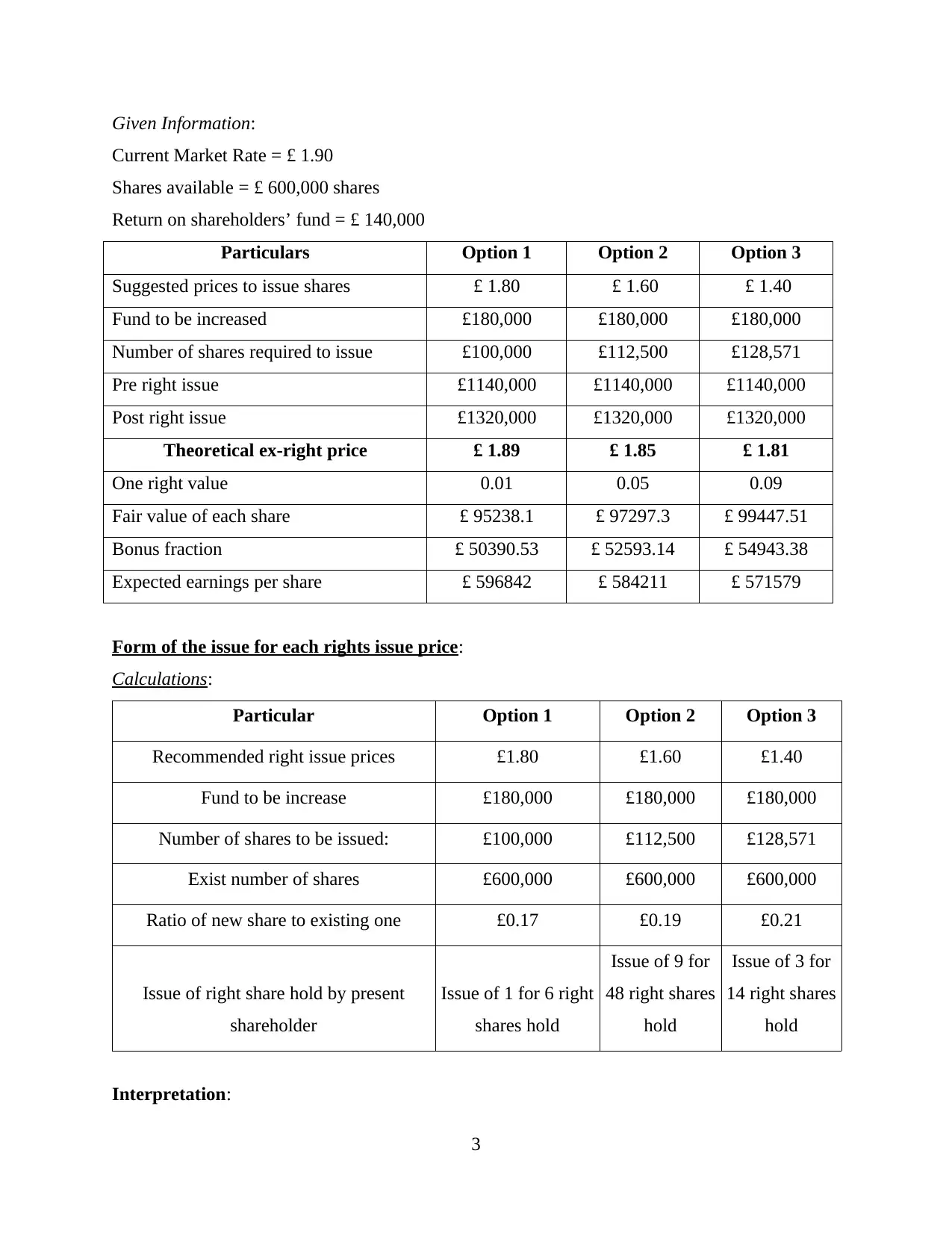
Given Information:
Current Market Rate = £ 1.90
Shares available = £ 600,000 shares
Return on shareholders’ fund = £ 140,000
Particulars Option 1 Option 2 Option 3
Suggested prices to issue shares £ 1.80 £ 1.60 £ 1.40
Fund to be increased £180,000 £180,000 £180,000
Number of shares required to issue £100,000 £112,500 £128,571
Pre right issue £1140,000 £1140,000 £1140,000
Post right issue £1320,000 £1320,000 £1320,000
Theoretical ex-right price £ 1.89 £ 1.85 £ 1.81
One right value 0.01 0.05 0.09
Fair value of each share £ 95238.1 £ 97297.3 £ 99447.51
Bonus fraction £ 50390.53 £ 52593.14 £ 54943.38
Expected earnings per share £ 596842 £ 584211 £ 571579
Form of the issue for each rights issue price:
Calculations:
Particular Option 1 Option 2 Option 3
Recommended right issue prices £1.80 £1.60 £1.40
Fund to be increase £180,000 £180,000 £180,000
Number of shares to be issued: £100,000 £112,500 £128,571
Exist number of shares £600,000 £600,000 £600,000
Ratio of new share to existing one £0.17 £0.19 £0.21
Issue of right share hold by present
shareholder
Issue of 1 for 6 right
shares hold
Issue of 9 for
48 right shares
hold
Issue of 3 for
14 right shares
hold
Interpretation:
3
Current Market Rate = £ 1.90
Shares available = £ 600,000 shares
Return on shareholders’ fund = £ 140,000
Particulars Option 1 Option 2 Option 3
Suggested prices to issue shares £ 1.80 £ 1.60 £ 1.40
Fund to be increased £180,000 £180,000 £180,000
Number of shares required to issue £100,000 £112,500 £128,571
Pre right issue £1140,000 £1140,000 £1140,000
Post right issue £1320,000 £1320,000 £1320,000
Theoretical ex-right price £ 1.89 £ 1.85 £ 1.81
One right value 0.01 0.05 0.09
Fair value of each share £ 95238.1 £ 97297.3 £ 99447.51
Bonus fraction £ 50390.53 £ 52593.14 £ 54943.38
Expected earnings per share £ 596842 £ 584211 £ 571579
Form of the issue for each rights issue price:
Calculations:
Particular Option 1 Option 2 Option 3
Recommended right issue prices £1.80 £1.60 £1.40
Fund to be increase £180,000 £180,000 £180,000
Number of shares to be issued: £100,000 £112,500 £128,571
Exist number of shares £600,000 £600,000 £600,000
Ratio of new share to existing one £0.17 £0.19 £0.21
Issue of right share hold by present
shareholder
Issue of 1 for 6 right
shares hold
Issue of 9 for
48 right shares
hold
Issue of 3 for
14 right shares
hold
Interpretation:
3
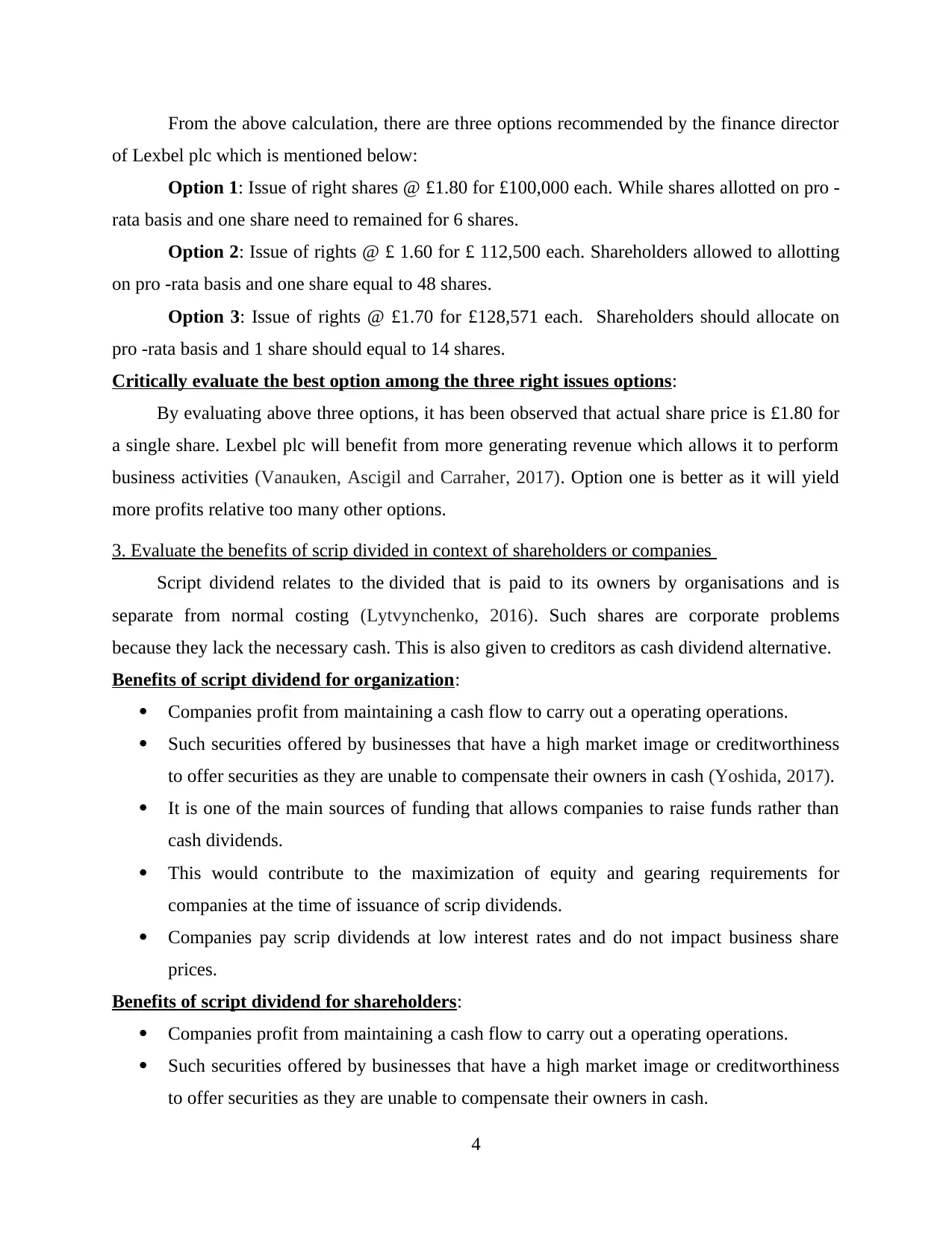
From the above calculation, there are three options recommended by the finance director
of Lexbel plc which is mentioned below:
Option 1: Issue of right shares @ £1.80 for £100,000 each. While shares allotted on pro -
rata basis and one share need to remained for 6 shares.
Option 2: Issue of rights @ £ 1.60 for £ 112,500 each. Shareholders allowed to allotting
on pro -rata basis and one share equal to 48 shares.
Option 3: Issue of rights @ £1.70 for £128,571 each. Shareholders should allocate on
pro -rata basis and 1 share should equal to 14 shares.
Critically evaluate the best option among the three right issues options:
By evaluating above three options, it has been observed that actual share price is £1.80 for
a single share. Lexbel plc will benefit from more generating revenue which allows it to perform
business activities (Vanauken, Ascigil and Carraher, 2017). Option one is better as it will yield
more profits relative too many other options.
3. Evaluate the benefits of scrip divided in context of shareholders or companies
Script dividend relates to the divided that is paid to its owners by organisations and is
separate from normal costing (Lytvynchenko, 2016). Such shares are corporate problems
because they lack the necessary cash. This is also given to creditors as cash dividend alternative.
Benefits of script dividend for organization:
Companies profit from maintaining a cash flow to carry out a operating operations.
Such securities offered by businesses that have a high market image or creditworthiness
to offer securities as they are unable to compensate their owners in cash (Yoshida, 2017).
It is one of the main sources of funding that allows companies to raise funds rather than
cash dividends.
This would contribute to the maximization of equity and gearing requirements for
companies at the time of issuance of scrip dividends.
Companies pay scrip dividends at low interest rates and do not impact business share
prices.
Benefits of script dividend for shareholders:
Companies profit from maintaining a cash flow to carry out a operating operations.
Such securities offered by businesses that have a high market image or creditworthiness
to offer securities as they are unable to compensate their owners in cash.
4
of Lexbel plc which is mentioned below:
Option 1: Issue of right shares @ £1.80 for £100,000 each. While shares allotted on pro -
rata basis and one share need to remained for 6 shares.
Option 2: Issue of rights @ £ 1.60 for £ 112,500 each. Shareholders allowed to allotting
on pro -rata basis and one share equal to 48 shares.
Option 3: Issue of rights @ £1.70 for £128,571 each. Shareholders should allocate on
pro -rata basis and 1 share should equal to 14 shares.
Critically evaluate the best option among the three right issues options:
By evaluating above three options, it has been observed that actual share price is £1.80 for
a single share. Lexbel plc will benefit from more generating revenue which allows it to perform
business activities (Vanauken, Ascigil and Carraher, 2017). Option one is better as it will yield
more profits relative too many other options.
3. Evaluate the benefits of scrip divided in context of shareholders or companies
Script dividend relates to the divided that is paid to its owners by organisations and is
separate from normal costing (Lytvynchenko, 2016). Such shares are corporate problems
because they lack the necessary cash. This is also given to creditors as cash dividend alternative.
Benefits of script dividend for organization:
Companies profit from maintaining a cash flow to carry out a operating operations.
Such securities offered by businesses that have a high market image or creditworthiness
to offer securities as they are unable to compensate their owners in cash (Yoshida, 2017).
It is one of the main sources of funding that allows companies to raise funds rather than
cash dividends.
This would contribute to the maximization of equity and gearing requirements for
companies at the time of issuance of scrip dividends.
Companies pay scrip dividends at low interest rates and do not impact business share
prices.
Benefits of script dividend for shareholders:
Companies profit from maintaining a cash flow to carry out a operating operations.
Such securities offered by businesses that have a high market image or creditworthiness
to offer securities as they are unable to compensate their owners in cash.
4
⊘ This is a preview!⊘
Do you want full access?
Subscribe today to unlock all pages.

Trusted by 1+ million students worldwide
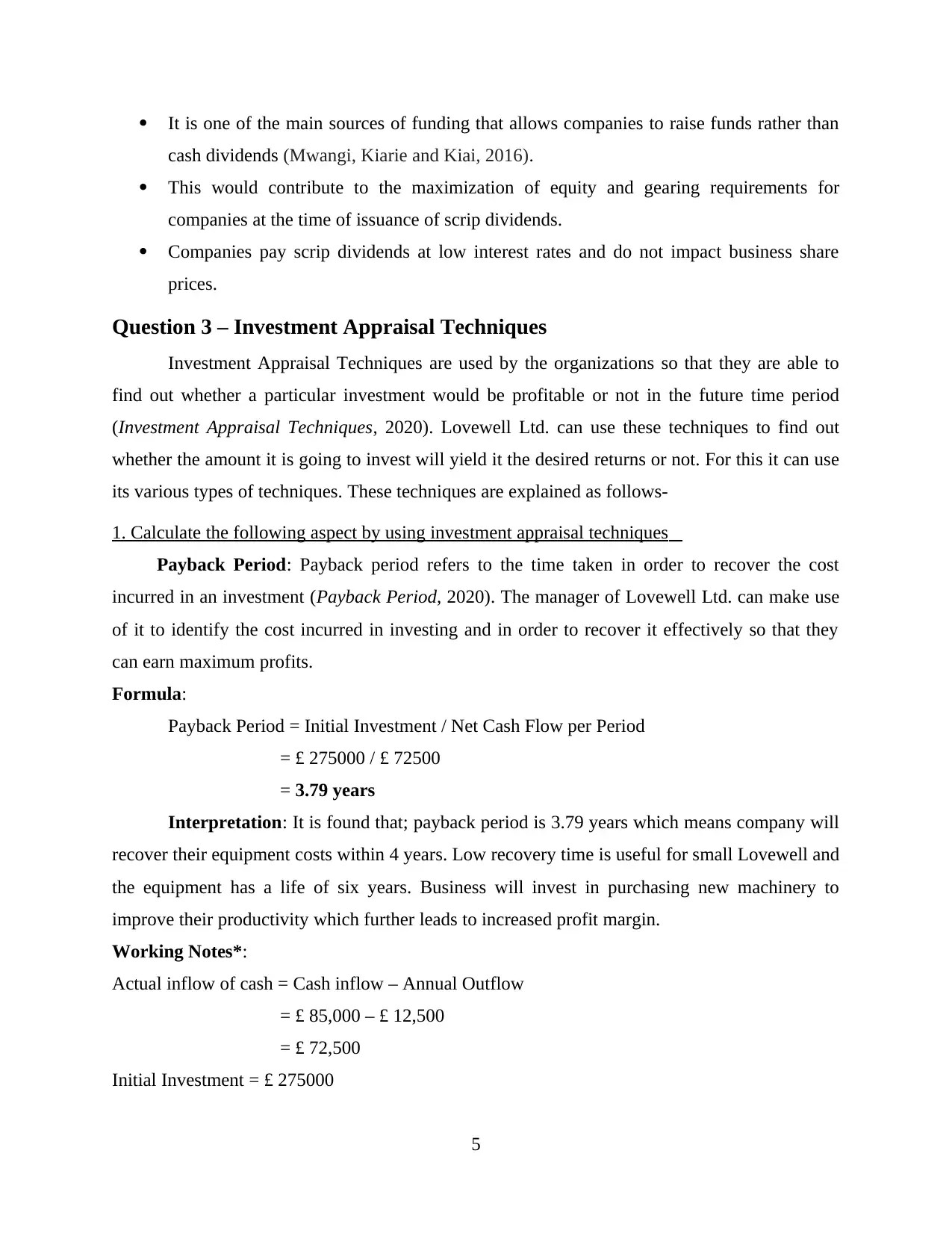
It is one of the main sources of funding that allows companies to raise funds rather than
cash dividends (Mwangi, Kiarie and Kiai, 2016).
This would contribute to the maximization of equity and gearing requirements for
companies at the time of issuance of scrip dividends.
Companies pay scrip dividends at low interest rates and do not impact business share
prices.
Question 3 – Investment Appraisal Techniques
Investment Appraisal Techniques are used by the organizations so that they are able to
find out whether a particular investment would be profitable or not in the future time period
(Investment Appraisal Techniques, 2020). Lovewell Ltd. can use these techniques to find out
whether the amount it is going to invest will yield it the desired returns or not. For this it can use
its various types of techniques. These techniques are explained as follows-
1. Calculate the following aspect by using investment appraisal techniques
Payback Period: Payback period refers to the time taken in order to recover the cost
incurred in an investment (Payback Period, 2020). The manager of Lovewell Ltd. can make use
of it to identify the cost incurred in investing and in order to recover it effectively so that they
can earn maximum profits.
Formula:
Payback Period = Initial Investment / Net Cash Flow per Period
= £ 275000 / £ 72500
= 3.79 years
Interpretation: It is found that; payback period is 3.79 years which means company will
recover their equipment costs within 4 years. Low recovery time is useful for small Lovewell and
the equipment has a life of six years. Business will invest in purchasing new machinery to
improve their productivity which further leads to increased profit margin.
Working Notes*:
Actual inflow of cash = Cash inflow – Annual Outflow
= £ 85,000 – £ 12,500
= £ 72,500
Initial Investment = £ 275000
5
cash dividends (Mwangi, Kiarie and Kiai, 2016).
This would contribute to the maximization of equity and gearing requirements for
companies at the time of issuance of scrip dividends.
Companies pay scrip dividends at low interest rates and do not impact business share
prices.
Question 3 – Investment Appraisal Techniques
Investment Appraisal Techniques are used by the organizations so that they are able to
find out whether a particular investment would be profitable or not in the future time period
(Investment Appraisal Techniques, 2020). Lovewell Ltd. can use these techniques to find out
whether the amount it is going to invest will yield it the desired returns or not. For this it can use
its various types of techniques. These techniques are explained as follows-
1. Calculate the following aspect by using investment appraisal techniques
Payback Period: Payback period refers to the time taken in order to recover the cost
incurred in an investment (Payback Period, 2020). The manager of Lovewell Ltd. can make use
of it to identify the cost incurred in investing and in order to recover it effectively so that they
can earn maximum profits.
Formula:
Payback Period = Initial Investment / Net Cash Flow per Period
= £ 275000 / £ 72500
= 3.79 years
Interpretation: It is found that; payback period is 3.79 years which means company will
recover their equipment costs within 4 years. Low recovery time is useful for small Lovewell and
the equipment has a life of six years. Business will invest in purchasing new machinery to
improve their productivity which further leads to increased profit margin.
Working Notes*:
Actual inflow of cash = Cash inflow – Annual Outflow
= £ 85,000 – £ 12,500
= £ 72,500
Initial Investment = £ 275000
5
Paraphrase This Document
Need a fresh take? Get an instant paraphrase of this document with our AI Paraphraser
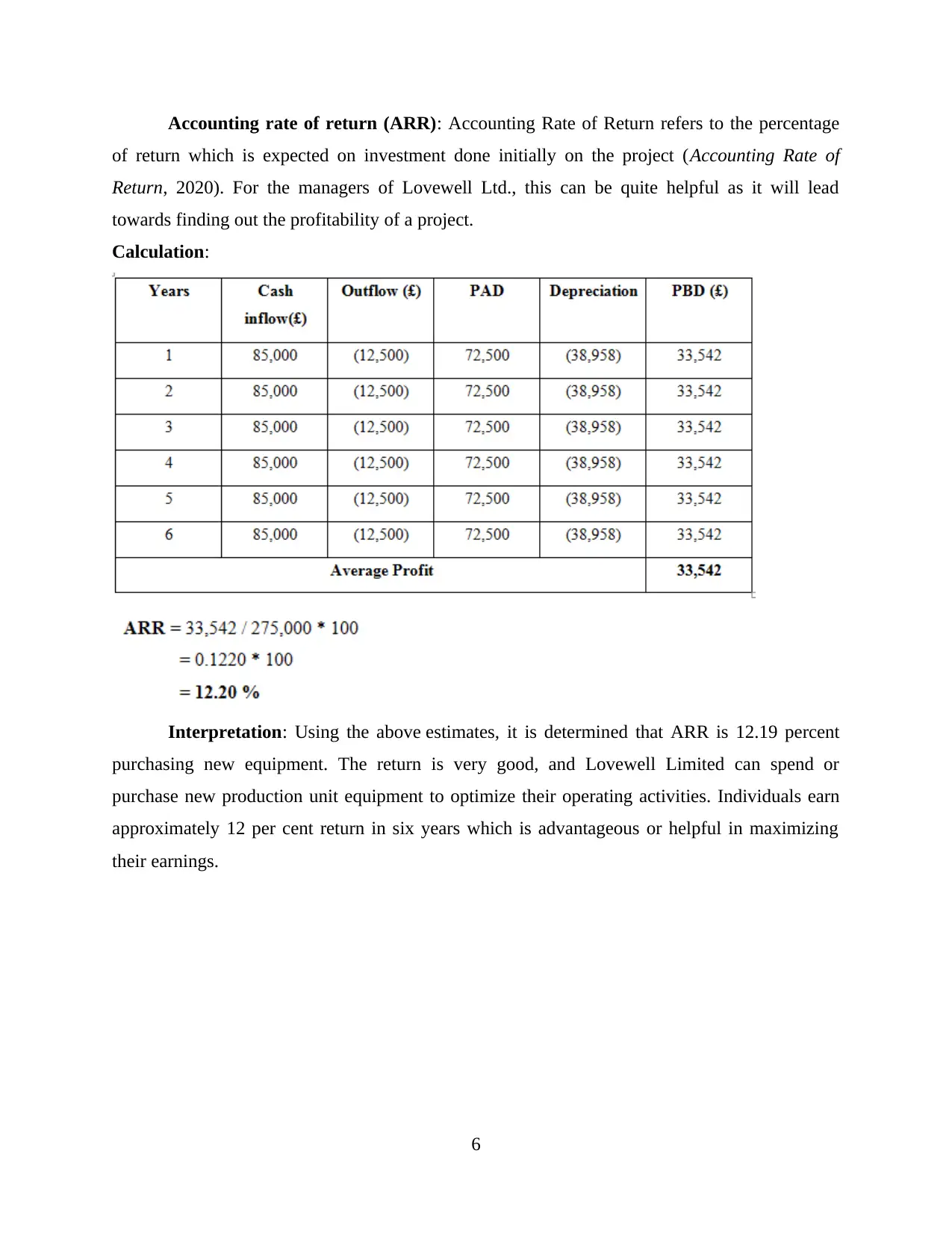
Accounting rate of return (ARR): Accounting Rate of Return refers to the percentage
of return which is expected on investment done initially on the project (Accounting Rate of
Return, 2020). For the managers of Lovewell Ltd., this can be quite helpful as it will lead
towards finding out the profitability of a project.
Calculation:
Interpretation: Using the above estimates, it is determined that ARR is 12.19 percent
purchasing new equipment. The return is very good, and Lovewell Limited can spend or
purchase new production unit equipment to optimize their operating activities. Individuals earn
approximately 12 per cent return in six years which is advantageous or helpful in maximizing
their earnings.
6
of return which is expected on investment done initially on the project (Accounting Rate of
Return, 2020). For the managers of Lovewell Ltd., this can be quite helpful as it will lead
towards finding out the profitability of a project.
Calculation:
Interpretation: Using the above estimates, it is determined that ARR is 12.19 percent
purchasing new equipment. The return is very good, and Lovewell Limited can spend or
purchase new production unit equipment to optimize their operating activities. Individuals earn
approximately 12 per cent return in six years which is advantageous or helpful in maximizing
their earnings.
6
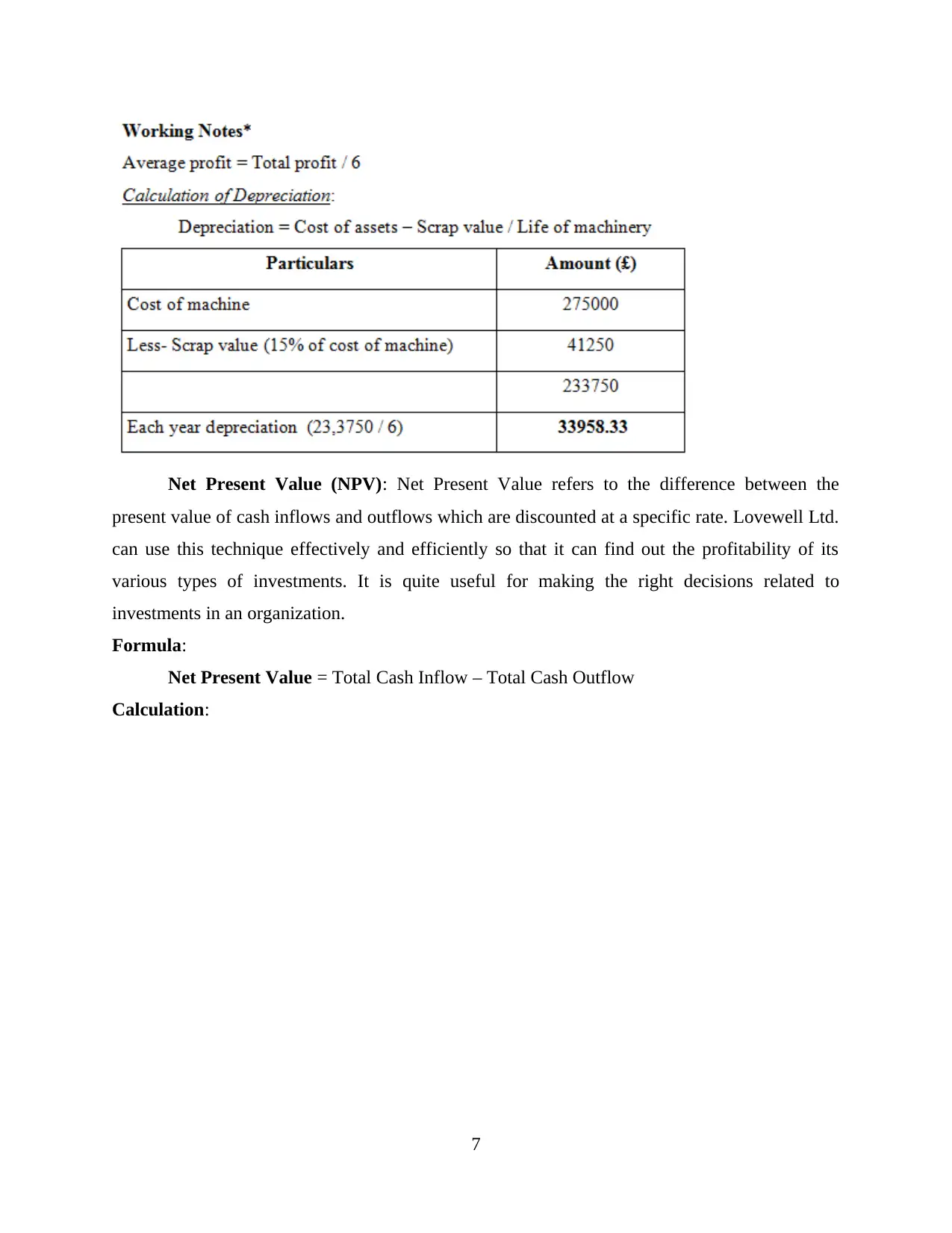
Net Present Value (NPV): Net Present Value refers to the difference between the
present value of cash inflows and outflows which are discounted at a specific rate. Lovewell Ltd.
can use this technique effectively and efficiently so that it can find out the profitability of its
various types of investments. It is quite useful for making the right decisions related to
investments in an organization.
Formula:
Net Present Value = Total Cash Inflow – Total Cash Outflow
Calculation:
7
present value of cash inflows and outflows which are discounted at a specific rate. Lovewell Ltd.
can use this technique effectively and efficiently so that it can find out the profitability of its
various types of investments. It is quite useful for making the right decisions related to
investments in an organization.
Formula:
Net Present Value = Total Cash Inflow – Total Cash Outflow
Calculation:
7
⊘ This is a preview!⊘
Do you want full access?
Subscribe today to unlock all pages.

Trusted by 1+ million students worldwide
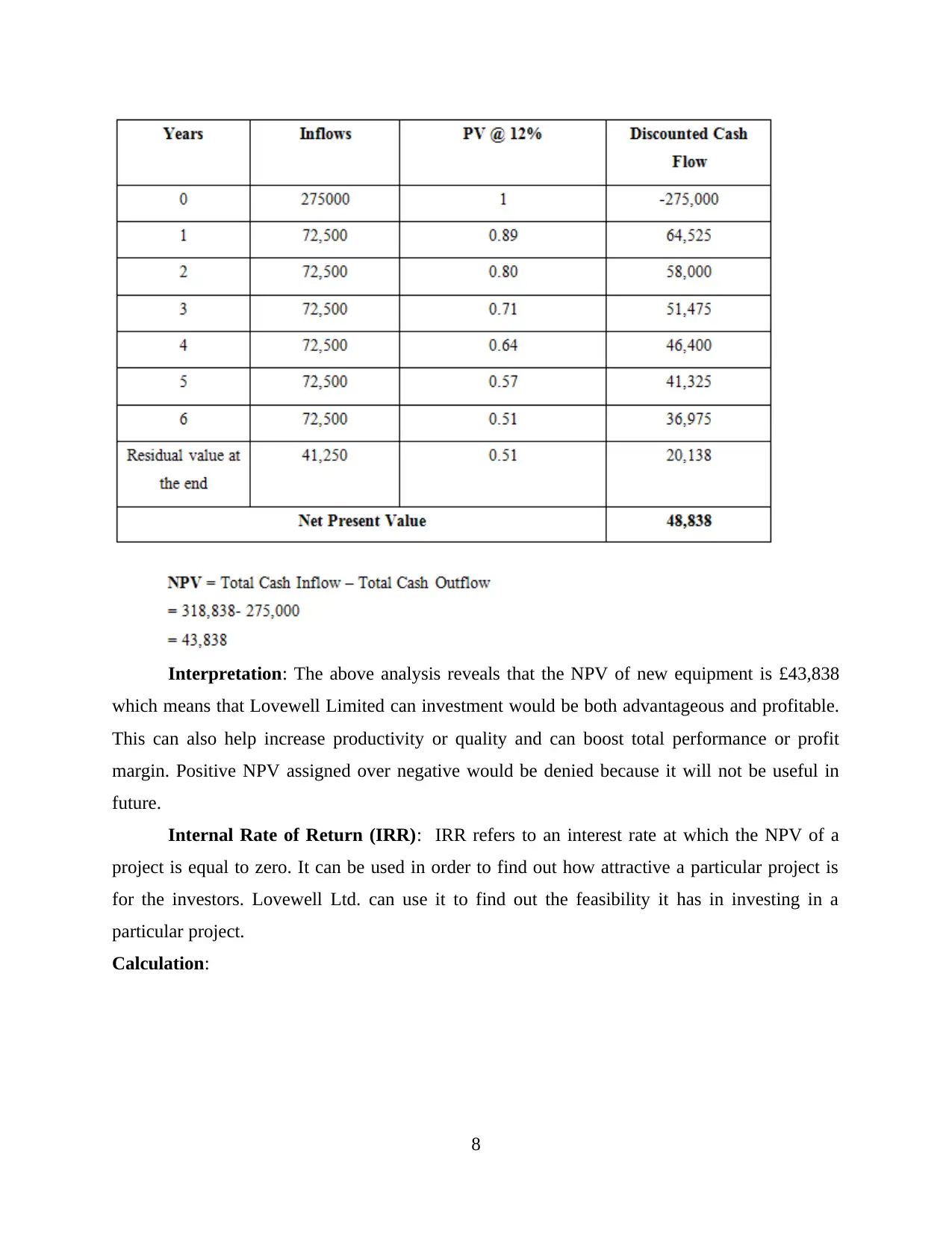
Interpretation: The above analysis reveals that the NPV of new equipment is £43,838
which means that Lovewell Limited can investment would be both advantageous and profitable.
This can also help increase productivity or quality and can boost total performance or profit
margin. Positive NPV assigned over negative would be denied because it will not be useful in
future.
Internal Rate of Return (IRR): IRR refers to an interest rate at which the NPV of a
project is equal to zero. It can be used in order to find out how attractive a particular project is
for the investors. Lovewell Ltd. can use it to find out the feasibility it has in investing in a
particular project.
Calculation:
8
which means that Lovewell Limited can investment would be both advantageous and profitable.
This can also help increase productivity or quality and can boost total performance or profit
margin. Positive NPV assigned over negative would be denied because it will not be useful in
future.
Internal Rate of Return (IRR): IRR refers to an interest rate at which the NPV of a
project is equal to zero. It can be used in order to find out how attractive a particular project is
for the investors. Lovewell Ltd. can use it to find out the feasibility it has in investing in a
particular project.
Calculation:
8
Paraphrase This Document
Need a fresh take? Get an instant paraphrase of this document with our AI Paraphraser
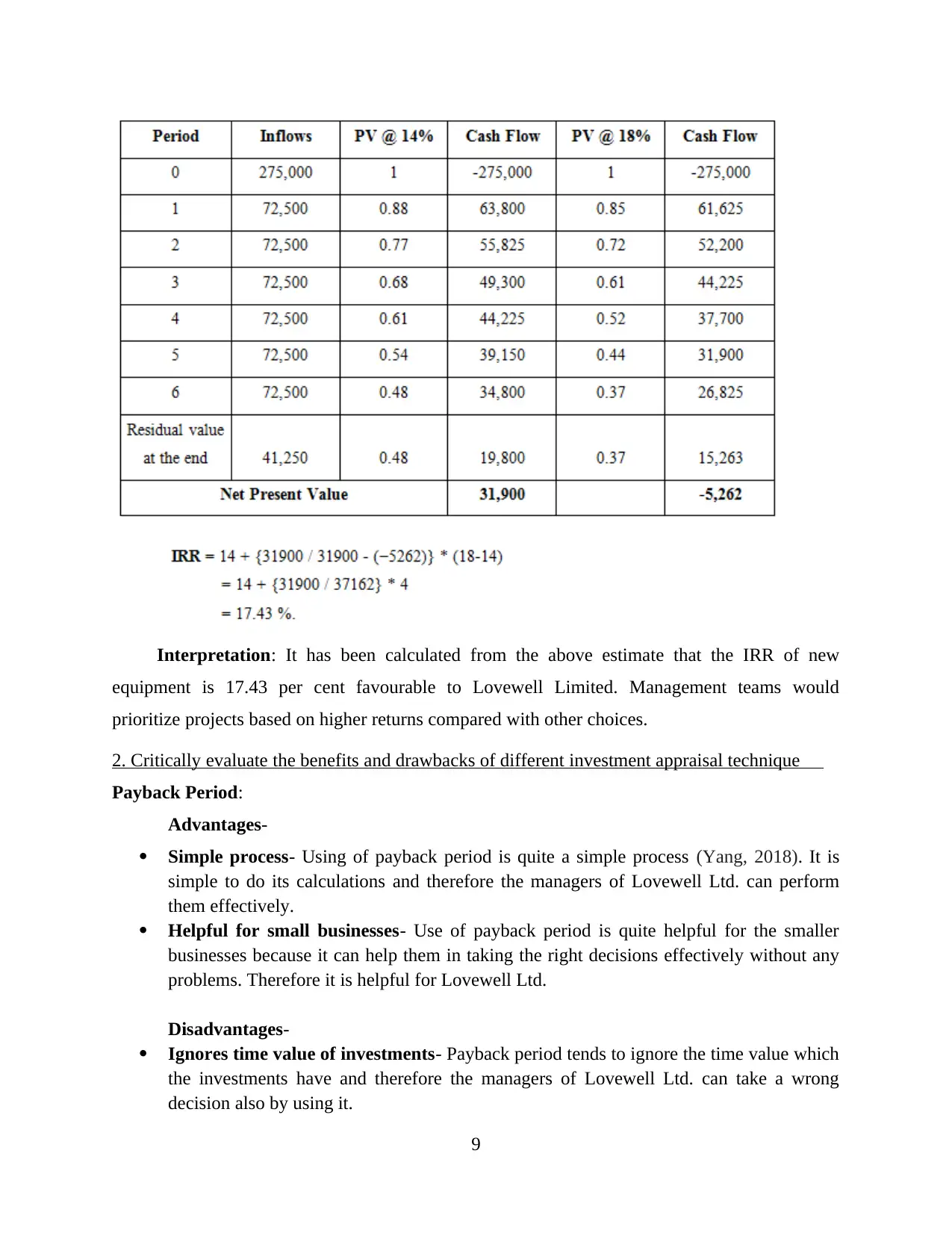
Interpretation: It has been calculated from the above estimate that the IRR of new
equipment is 17.43 per cent favourable to Lovewell Limited. Management teams would
prioritize projects based on higher returns compared with other choices.
2. Critically evaluate the benefits and drawbacks of different investment appraisal technique
Payback Period:
Advantages-
Simple process- Using of payback period is quite a simple process (Yang, 2018). It is
simple to do its calculations and therefore the managers of Lovewell Ltd. can perform
them effectively.
Helpful for small businesses- Use of payback period is quite helpful for the smaller
businesses because it can help them in taking the right decisions effectively without any
problems. Therefore it is helpful for Lovewell Ltd.
Disadvantages-
Ignores time value of investments- Payback period tends to ignore the time value which
the investments have and therefore the managers of Lovewell Ltd. can take a wrong
decision also by using it.
9
equipment is 17.43 per cent favourable to Lovewell Limited. Management teams would
prioritize projects based on higher returns compared with other choices.
2. Critically evaluate the benefits and drawbacks of different investment appraisal technique
Payback Period:
Advantages-
Simple process- Using of payback period is quite a simple process (Yang, 2018). It is
simple to do its calculations and therefore the managers of Lovewell Ltd. can perform
them effectively.
Helpful for small businesses- Use of payback period is quite helpful for the smaller
businesses because it can help them in taking the right decisions effectively without any
problems. Therefore it is helpful for Lovewell Ltd.
Disadvantages-
Ignores time value of investments- Payback period tends to ignore the time value which
the investments have and therefore the managers of Lovewell Ltd. can take a wrong
decision also by using it.
9
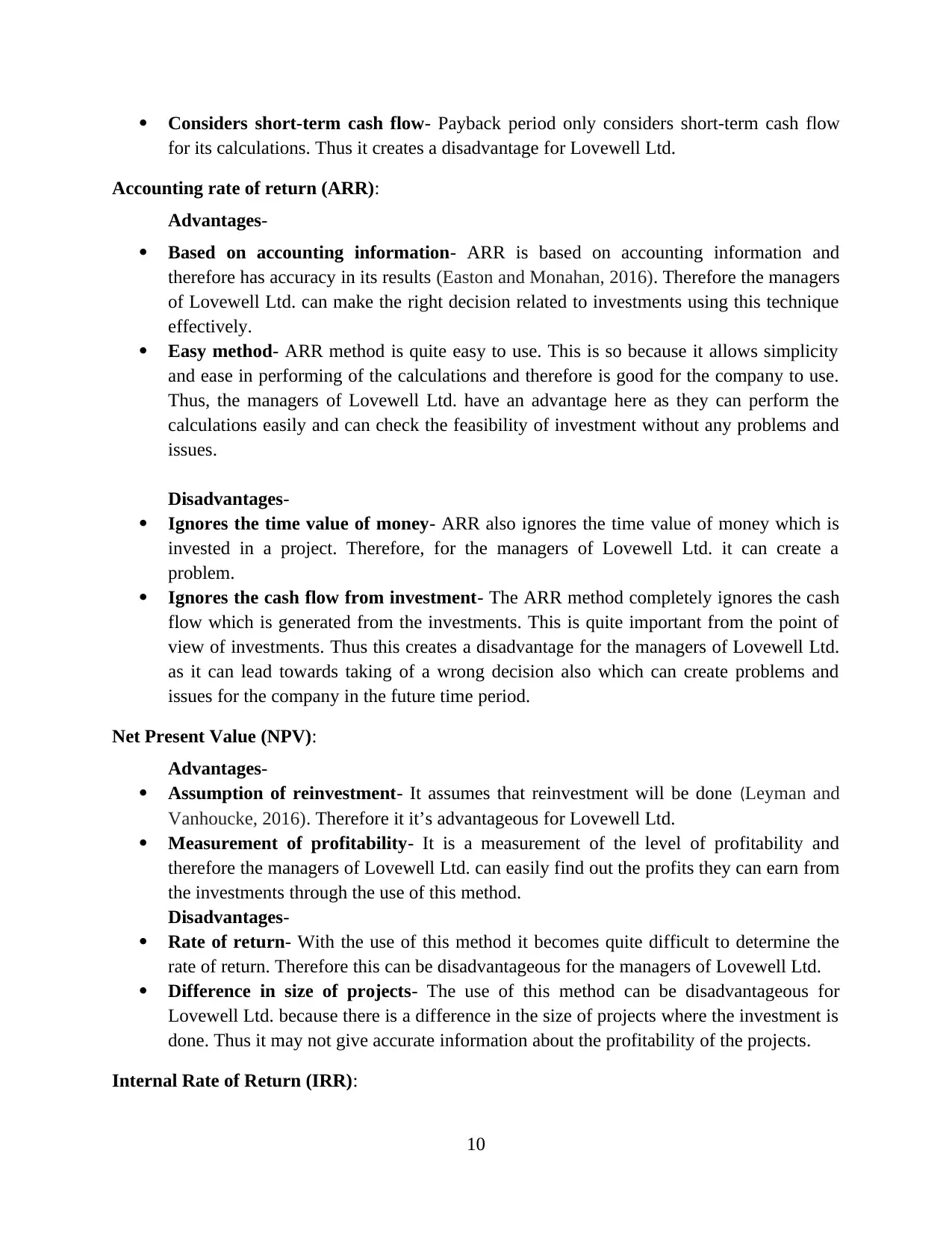
Considers short-term cash flow- Payback period only considers short-term cash flow
for its calculations. Thus it creates a disadvantage for Lovewell Ltd.
Accounting rate of return (ARR):
Advantages-
Based on accounting information- ARR is based on accounting information and
therefore has accuracy in its results (Easton and Monahan, 2016). Therefore the managers
of Lovewell Ltd. can make the right decision related to investments using this technique
effectively.
Easy method- ARR method is quite easy to use. This is so because it allows simplicity
and ease in performing of the calculations and therefore is good for the company to use.
Thus, the managers of Lovewell Ltd. have an advantage here as they can perform the
calculations easily and can check the feasibility of investment without any problems and
issues.
Disadvantages-
Ignores the time value of money- ARR also ignores the time value of money which is
invested in a project. Therefore, for the managers of Lovewell Ltd. it can create a
problem.
Ignores the cash flow from investment- The ARR method completely ignores the cash
flow which is generated from the investments. This is quite important from the point of
view of investments. Thus this creates a disadvantage for the managers of Lovewell Ltd.
as it can lead towards taking of a wrong decision also which can create problems and
issues for the company in the future time period.
Net Present Value (NPV):
Advantages-
Assumption of reinvestment- It assumes that reinvestment will be done (Leyman and
Vanhoucke, 2016). Therefore it it’s advantageous for Lovewell Ltd.
Measurement of profitability- It is a measurement of the level of profitability and
therefore the managers of Lovewell Ltd. can easily find out the profits they can earn from
the investments through the use of this method.
Disadvantages-
Rate of return- With the use of this method it becomes quite difficult to determine the
rate of return. Therefore this can be disadvantageous for the managers of Lovewell Ltd.
Difference in size of projects- The use of this method can be disadvantageous for
Lovewell Ltd. because there is a difference in the size of projects where the investment is
done. Thus it may not give accurate information about the profitability of the projects.
Internal Rate of Return (IRR):
10
for its calculations. Thus it creates a disadvantage for Lovewell Ltd.
Accounting rate of return (ARR):
Advantages-
Based on accounting information- ARR is based on accounting information and
therefore has accuracy in its results (Easton and Monahan, 2016). Therefore the managers
of Lovewell Ltd. can make the right decision related to investments using this technique
effectively.
Easy method- ARR method is quite easy to use. This is so because it allows simplicity
and ease in performing of the calculations and therefore is good for the company to use.
Thus, the managers of Lovewell Ltd. have an advantage here as they can perform the
calculations easily and can check the feasibility of investment without any problems and
issues.
Disadvantages-
Ignores the time value of money- ARR also ignores the time value of money which is
invested in a project. Therefore, for the managers of Lovewell Ltd. it can create a
problem.
Ignores the cash flow from investment- The ARR method completely ignores the cash
flow which is generated from the investments. This is quite important from the point of
view of investments. Thus this creates a disadvantage for the managers of Lovewell Ltd.
as it can lead towards taking of a wrong decision also which can create problems and
issues for the company in the future time period.
Net Present Value (NPV):
Advantages-
Assumption of reinvestment- It assumes that reinvestment will be done (Leyman and
Vanhoucke, 2016). Therefore it it’s advantageous for Lovewell Ltd.
Measurement of profitability- It is a measurement of the level of profitability and
therefore the managers of Lovewell Ltd. can easily find out the profits they can earn from
the investments through the use of this method.
Disadvantages-
Rate of return- With the use of this method it becomes quite difficult to determine the
rate of return. Therefore this can be disadvantageous for the managers of Lovewell Ltd.
Difference in size of projects- The use of this method can be disadvantageous for
Lovewell Ltd. because there is a difference in the size of projects where the investment is
done. Thus it may not give accurate information about the profitability of the projects.
Internal Rate of Return (IRR):
10
⊘ This is a preview!⊘
Do you want full access?
Subscribe today to unlock all pages.

Trusted by 1+ million students worldwide
1 out of 14
Related Documents
Your All-in-One AI-Powered Toolkit for Academic Success.
+13062052269
info@desklib.com
Available 24*7 on WhatsApp / Email
![[object Object]](/_next/static/media/star-bottom.7253800d.svg)
Unlock your academic potential
Copyright © 2020–2025 A2Z Services. All Rights Reserved. Developed and managed by ZUCOL.




